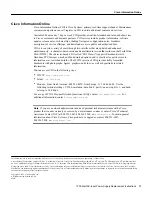
6 1200-Watt AC-Input Power Supply Replacement Instructions
Environmental Monitoring and Reporting Functions
Environmental Monitoring
Three sensors on the Route Switch Processor (RSP2) monitor the temperature of the cooling air that
flows through the processor slots: inlet, hotpoint, and exhaust. The sensors are located at the bottom,
center, and top of the RSP2, when facing the interface processor end of the chassis and viewing the
RSP2 as it is installed.
The power supply uses the Normal, Critical, and Warning levels to monitor DC voltages. Table 2
lists temperature thresholds for the three processor-monitored levels. Table 3 lists the DC power
thresholds for the Normal and Critical (power-supply-monitored) levels.
•
Normal—All monitored parameters are within normal tolerances. The system blower operates at
55 percent of its maximum speed if the internal air temperature does not exceed this level.
•
Warning (low and high)—The system is approaching an out-of-tolerance condition. The system
will continue to operate, but operator monitoring or action is recommended to bring the system
back to a normal state. If the internal air temperature the normal range, the blower speed will
increase linearly from 55 percent of maximum speed until it reaches 100 percent speed at 33C
(91F).
•
Critical (low and high)—An out-of-tolerance temperature or voltage condition exists. The
system may not continue operation. If a voltage measurement reaches this level, the power supply
can shut down the system. If the blower fails, the system will display a warning message and shut
down in two minutes. Immediate operator action is required.
•
Processor shutdown—The chassis interface has detected a temperature or blower-failure
condition that could result in physical damage to system components and has disabled DC power
to all interface processors (in slots 0 through 5 and 8 through 12). DC power to the RSP2, chassis
interface, and blower stays on, but no RSP2-related processing takes place. Immediate operator
action is required. DC power remains off until the inside temperature of the chassis reaches 40C
(104F), at which point the system will restart up to 15 times (if required). If the source of the
shutdown has not been corrected, the system will execute a hard shutdown. Before any shutdown,
the system logs the status of monitored parameters in NVRAM so that you can retrieve it later to
help determine the cause of the problem.
•
Power supply shutdown—An out-of-tolerance voltage, current, or temperature condition was
detected within the power supply and it was shut down (or a shutdown is imminent). All DC
power remains disabled until the operator toggles the power switch and corrects the problem that
caused the shutdown (if any). This condition typically occurs because of one of the following
reasons:
— Loss of AC input power (the power source failed).
— Power supply detected an overvoltage, overcurrent, AC or DC undervoltage, or
overtemperature condition within the power supply. This includes operator shutdown by
turning off the system power switch, which the power supply interprets as an undervoltage
condition.
— The chassis interface detected an overtemperature condition within the system.
•
Blower failure—The blower impeller has stopped turning. A warning message is displayed on
the console, and the system will continue operating until it shuts itself down due to overheating.




































